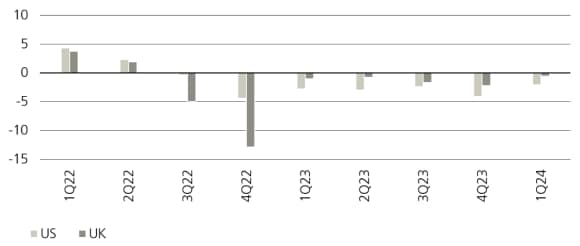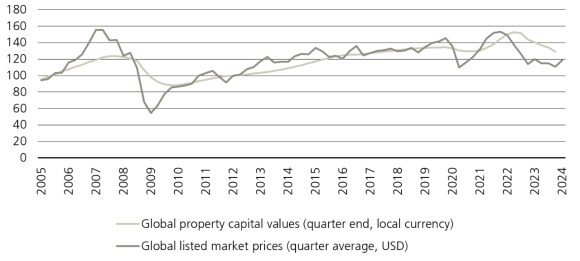Real Estate Outlook – Global, Edition May 2024
Approaching the bottom

Real estate investment activity staged a modest recovery in the first quarter, though remained very muted on a historical basis. Capital values showed further declines in the US and UK, though the market looks to be approaching bottom. Prime yields in Tokyo edged higher as Japanese interest rate expectations crept up.
Fergus Hicks, Real Estate Strategist
Pace of capital value decline eases
Pace of capital value decline eases
In the first three months of 2024 US economic growth was positive, but weaker than expected. GDP expanded at an annualized pace of 1.6% quarter on quarter (QoQ), a sharp downshift from the 3.4% annualized in 4Q23. China’s GDP grew 1.6% QoQ, slightly stronger than the 1.2% QoQ growth in 4Q23, while annual growth was 5.3% year on year (YoY), slightly above the government’s official target of ~5%. The housing market continues to weigh on the Chinese economy, though manufacturing activity has picked up.
Preliminary figures showed that the eurozone economy bounced back in 1Q24, growing 0.3% QoQ. These figures follow, on revised data, a brief technical recession in the second half of 2023. Strength in the 1Q24 economy was widespread, with Spain expanding 0.7% QoQ and Germany, which saw some quarterly falls in GDP in 2023, growing 0.2% QoQ. The eurozone jobs market continued to be robust, with the unemployment rate remaining at a record low of 6.5% in March. The US labor market also showed ongoing strength, with the unemployment rate rising marginally to 3.9% by April from the record low of 3.4% a year earlier.
In the US inflation ticked up in 1Q24 to reach 3.5% in March, while eurozone price pressures eased and inflation continued to fall, dropping to 2.4% in March, a 32-month low. Eurozone core inflation remained elevated at 2.9%, mainly driven by services inflation which can be explained as a temporary effect of the early Easter break. In both Europe and the US inflation is expected to trend towards 2%, though the final road will likely be bumpy.
The Swiss National Bank (SNB) led other major central banks by cutting interest rates in March, reducing them by 25bps to 1.50% . The European Central Bank (ECB) continued to keep interest rates on hold, with its deposit rate at 4.0%, but is expected to deliver its first cut in June. The Fed also held rates, in a target range of 5.25% to 5.50%, with expectations for multiple rate cuts this year slashed on inflation concerns. We think that US interest rates have peaked, though when the Fed starts cutting is less clear. Divergences in policy are emerging between the US, Europe and Japan, with the Bank of Japan ending its negative interest rate policy in March.
Real estate investment volumes across the globe remained subdued in 1Q24, with all property investment totaling USD 125 billion, down from USD 155 billion in 4Q23. However, after allowing for the seasonally quieter time of year, global real estate investment volumes increased 16% QoQ in USD terms. Despite this, volumes remained very low compared to historical averages and were still down 58% versus 2Q22, when prices peaked.
Globally, most sectors and geographies showed some improvement in activity but remained weak. After allowing for seasonal effects, Americas investment volumes increased 24% QoQ in 1Q24 in USD terms and EMEA volumes were up 16%, whereas APAC volumes slipped 4% QoQ, with the region not having declined to the same extent during the downturn as the Americas and EMEA. At the global level, after allowing for seasonal effects, investment volumes rose across sectors.
Price adjustment in real estate values continued in 1Q24, though the pace of decline eased. According to NCREIF, US capital values fell 2.1% QoQ and, according to MSCI, UK capital values dropped 0.6% QoQ (see Figure 1). The falls left UK capital values 22% below their mid-2022 peak and US values down 18% from their mid-2022 peak. In both markets offices continued to suffer, taking US office capital values to 32% below their 1Q22 peak and UK office values to 28% below their 2Q22 peak. Retail and industrial capital values were more resilient and did not show significant changes over the quarter. In the rest of Europe, the latest data available from MSCI showed capital values down 18% to 4Q23 from their mid-2022 peak.
Figure 1: Capital value growth (local currency, % QoQ)

According to MSCI, capital values in Japan were broadly flat between mid-2022 and end-2023, having not faced the pressure of higher interest rates that markets in Europe and North America have. In 1Q24, cumulative rises in global interest rates combined with expectations for small medium-term increases in Japanese rates to push prime yields in Tokyo slightly higher. According to CBRE, office yields rose 25bps QoQ and logistics yields 10bps QoQ. Retail yields were little changed, falling 5bps QoQ.
Two factors needed to spur investment market
Following sharp falls in capital values over the past eighteen months, investors remain cautious on real estate. They are sitting on the sidelines, waiting to deploy capital when they believe market circumstances to be more favorable. Two factors look necessary to spur investment activity. First, the commencement of interest rate cuts by central banks, and second, confidence amongst investors that real estate values have bottomed out.
Neither of these factors are currently in place, but they do not look far away. In the November 2023 edition of IPM, we highlighted the significant uncertainty over interest rates moving into 2024 and what different scenarios might mean for real estate markets. The analysis proved prescient since not even halfway through the year market expectations have swung wildly, from 6–7 cuts from the Fed in 2024 at the start of the year, to just one or two cuts on the latest market pricing. Expectations have been pared back as US inflation has crept up. Indeed, no rate cuts this year is a plausible outcome. The interest rate outlook is also diverging between the US and Europe. Overall, though, we still expect to see some cuts by year-end, with Europe leading the US.
With regard to the second factor, of when the market will bottom out, we think the correction is now well-advanced. However, it’s always hard, if not impossible, to pinpoint exactly when the bottom of the market will be. Higher frequency, listed markets can give a steer as to when real estate asset values might level off and listed markets have typically led property values by around two to three quarters. This was the case during the Global Financial Crisis (GFC) and pandemic-induced downturns (see Figure 2). Listed markets themselves have been hit by interest rate volatility towards the end of 2023 and in 2024. On the basis of average prices over the quarter, listed markets showed some recovery in 1Q24 and look to have bottomed out in 4Q23. This suggests that global property capital values will bottom out in 2Q or 3Q this year.
Hence moving into the second half of the year the two conditions needed for investors to deploy capital into real estate look like they will be met. This should prompt a pick-up in transaction activity at both the asset level and for real estate funds. The main risk to this outcome is inflation remaining high and sticky and central banks having to keep interest rates elevated for longer as a result. This could translate into further investor caution, weigh on real estate values and hold back recovery in the market. The US seems more at risk of this outcome than European markets, which have not seen the same uptick in inflation as the US.
For investors higher up the risk curve in the value-add and opportunistic space, apart from offices, the next 6–9 months may be the remaining window for them to lock in deals which benefit from distressed and discounted pricing. Cuts in interest rates should gradually relieve pressure on refinancings and make raising debt to finance new investments easier and more feasible. In the medium term, lower interest rates should see debt enhance returns again, although it is unlikely to be able to turbo-charge them like it did during the post-GFC decade of ultra-low interest rates.
Given the lower contribution from leverage, real estate investors need to look to good asset management to drive returns. This means ensuring full occupancy and rapid re-letting of space as leases end, and embarking on initiatives to improve assets and drive rental growth. As well raising the spec of buildings for occupiers and users, improvements also focus on the sustainability aspects of buildings and upgrading energy efficiency. This will make them more attractive to corporates and help them ensure they meet their net zero pathway targets.
We continue to think that the office sector will underperform and be marked by a sharp polarization between prime and secondary grade assets. Indeed, it is likely that a significant number of offices will eventually need to be repurposed, when feasible, to other uses, such as residential. Conversion to lab space is another possibility, subject to exacting building specs being met. We expect stronger performance for the retail, industrial and residential sectors and also the niche sectors such as self-storage and life sciences. Debt secured against real estate is also attractive in the higher interest rate environment, as banks focus on managing their existing loan books.
Figure 2: Capital value and price indices (1Q12 = 100)

Unlisted real estate sector performance outlook
Country | Country | Negative | Negative | - | - | Neutral | Neutral | - | - | Positive | Positive |
|---|---|---|---|---|---|---|---|---|---|---|---|
Country | US | Negative | Office | - | - | Neutral | Retail, industrial, residential, hotel | - | - | Positive | - |
Country | Canada | Negative | - | - | - | Neutral | Office, retail, industrial, residential, hotel | - | - | Positive | - |
Country | France | Negative | - | - | - | Neutral | Office, residential | - | Retail, hotel | Positive | Industrial |
Country | Germany | Negative | - | - | Office | Neutral | Retail, residential | - | Hotel | Positive | Industrial |
Country | Switzerland | Negative | - | - | - | Neutral | Office | - | Retail | Positive | Industrial, residential, hotel |
Country | UK | Negative | Office | - | - | Neutral | Residential, hotel | - | Retail | Positive | Industrial |
Country | Australia | Negative | - | - | Office | Neutral | - | - | Retail industrial, residential | Positive | Hotel |
Country | Japan | Negative | - | - | - | Neutral | - | - | Office | Positive | Retail, industrial, residential, hotel |
Country | Singapore | Negative | - | - | Office | Neutral | Retail | - | Industrial, hotel | Positive | - |
Want more insights?
Want more insights?
Subscribe to receive the latest private markets perspectives and insights across all sectors directly to your inbox.
Make an inquiry
Fill in an inquiry form and leave your details – we’ll be back in touch.
Introducing our leadership team
Meet the members of the team responsible for UBS Asset Management’s strategic direction.

